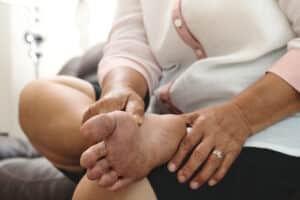
Did you know diabetes is the single greatest factor in amputations, with more than 60% of non-traumatic lower-limb amputations happening to diabetics? According to the American Diabetes Association, every 3.5 minutes a limb is amputated in the United States due to diabetes. Because these alarming statistics are on the rise, the Amputee Coalition believes it’s especially important for people with diabetes to know the facts to prevent a diabetic amputation.
How does diabetes increase the risk of amputation?
Diabetes is a condition in which the body does not produce insulin (Type 1) or use it properly (Type 2). Diabetes in any of its forms can cause nerve damage and reduced circulation, which can lead to limb loss.
Most lower-leg and foot amputations begin with foot sores known as ulcers. However, because diabetics may deal with peripheral diabetic neuropathy, which is a loss of feeling in the feet and legs, they are less likely to notice ulcers before they become more severe. When an ulcer doesn’t heal, it increases the risk of amputation due to severe damage to tissue and bone.
How can I prevent foot ulcers?
The best way is to manage your diabetes by eating healthy, exercising regularly, checking your blood sugar regularly, and taking your medicine correctly.
The good news is most amputations are preventable simply by checking your feet daily and wearing the right shoes to prevent injury.
Tips for foot care from Mayo Clinic:
- Examine your feet daily – Check for blisters, cuts, cracks, sores, redness, tenderness, or swelling, and visit a doctor immediately if you see signs of foot problems.
- Wash your feet every day – Use lukewarm water and dry them, especially between the toes. Use lotion to moisturize your feet to prevent cracks from dry skin.
- Don’t remove calluses or other foot lesions yourself – Visit your provider or podiatrist.
- Cut your toenails carefully – Cut straight across, and file sharp ends.
- Don’t walk barefoot – Not even inside the house
- Wear clean, dry socks – Moisture-wicking material such as cotton is best, not nylon. Avoid socks with tight elastic bands that reduce blood circulation.
- Buy shoes that fit correctly – Choose comfortable shoes with support and cushioning. Avoid tight-fitting shoes or ones that crowd your toes such as high heels.
- Don’t smoke – Smoking makes it harder for blood to go through your body.
- Schedule regular foot checkups – Your podiatrist can detect signs of nerve damage, poor circulation, etc.
It’s possible to avoid diabetic amputation and catch any potential issues early before they become a bigger problem. We encourage you to pay attention to your feet and share this knowledge with a friend. Together we can curb unnecessary limb loss in the United States!

